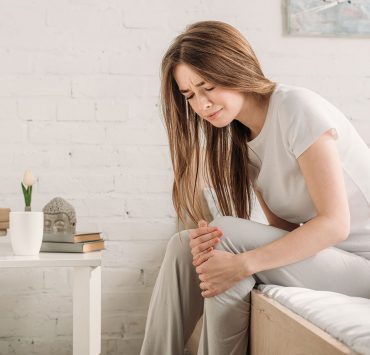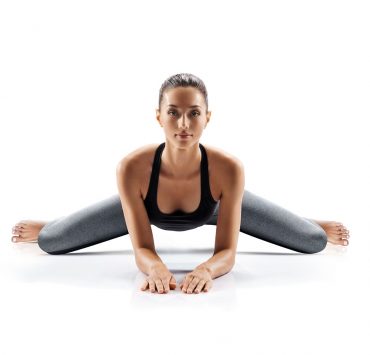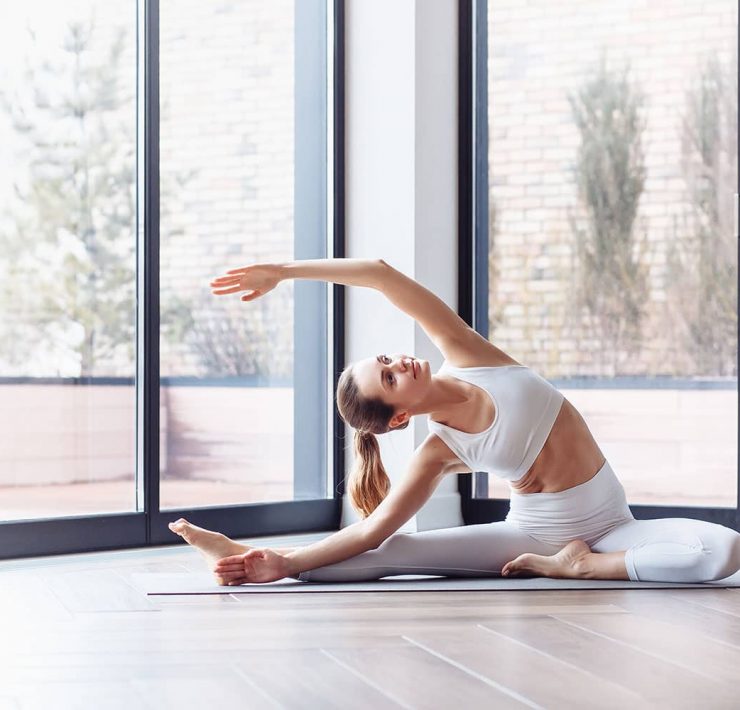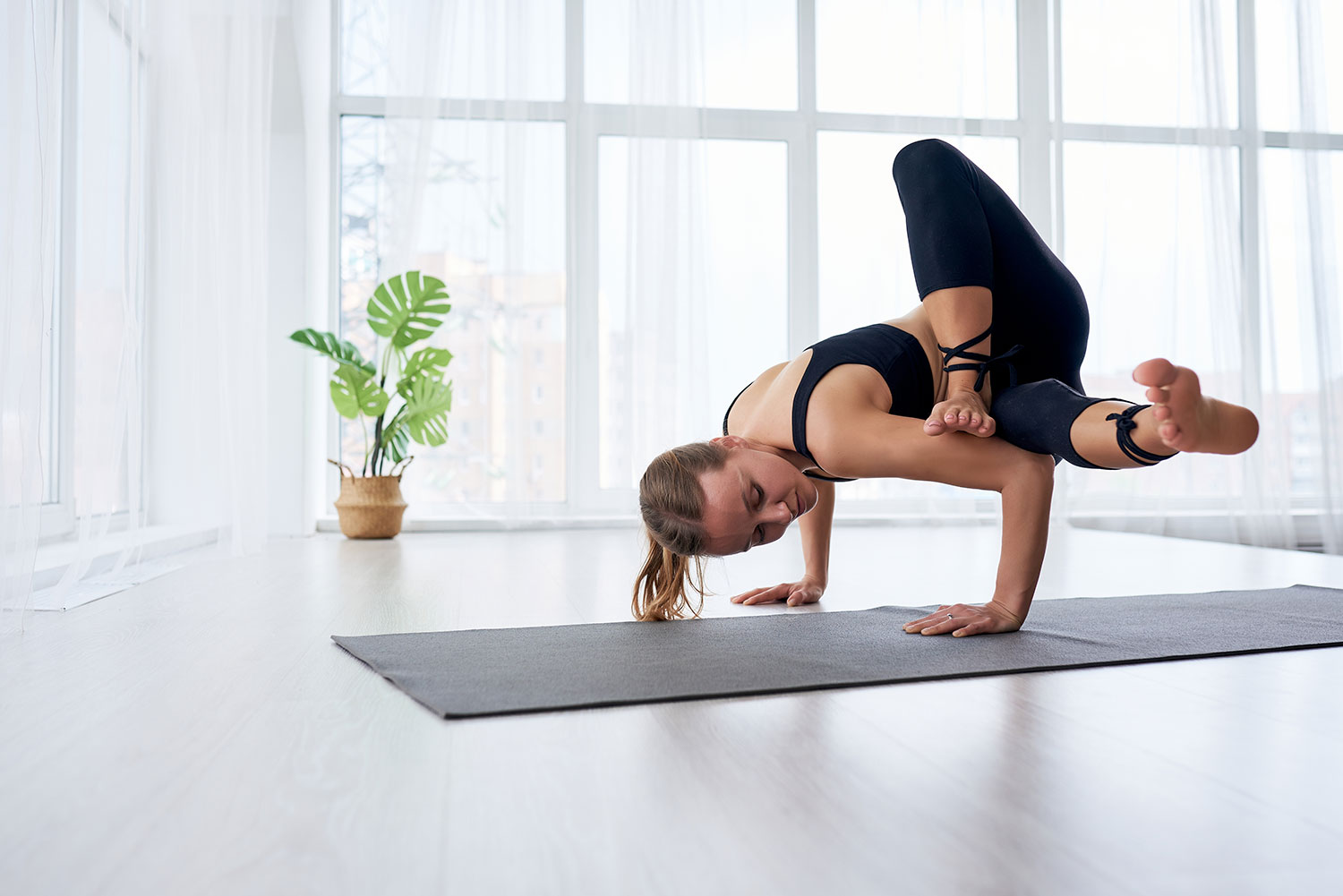
Meditation coach Emma Morrison is the go-to person for those…
Inversions and going upside down in yoga can be incredibly scary, but its benefits are beyond rewarding. Aside from other physical disciplines, inversions in yoga are meant to force us to see the world from a different perspective.
The benefits of inversions in yoga are threefold.
Psychologically, inversions allow us to open up to what scares us.
Emotionally, inversions allow us to guide the energy of the pelvis (the center of creation and personal power) closer to our heart, providing a space for self-exploration and inner growth.
Physically, inversions stimulate the immune and endocrine systems, invigorating and nourishing the brain and inner organs and releasing tension in the neck and spine.
Now that you’re familiar with the benefits of inversions, let’s explore these next 15 poses that you challenge your flexibility and strength.
#1 Astavakrasana — Eight Angle Pose
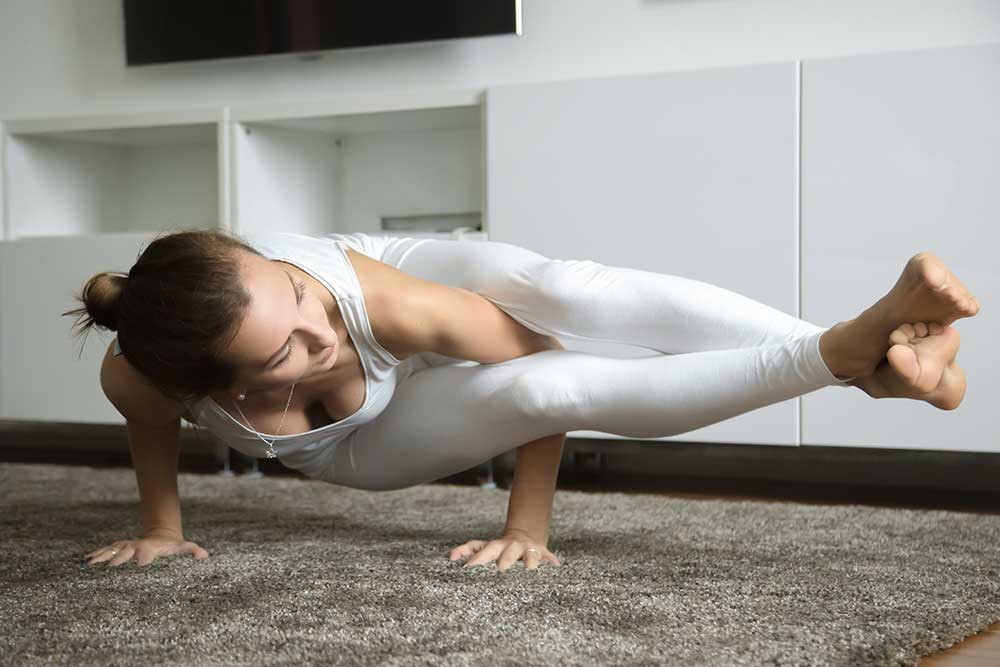
This is an arm balance twist that tests your strength and flexibility specifically in your arms, back, abs, and legs.
- Step 1: Sit on the mat in Dandasana and hug your right knee into your chest. Hook your knee over your shoulder or upper arm with your elbow bent. The back of your thigh should rest on your tricep and your left leg should still be extended out in front of you.
- Step 2: Place your palms on the mat shoulder-width apart and draw your shoulders back to lift your spine. Keep your core engaged and hook your left ankle around your right ankle with your knees still bent and feet flexing back.
- Step 3: Press into your hands and lift your legs and hips off of the mat. Bring your chest and shoulders forward and bend your elbows at a 90-degree angle.
- Step 4: Squeeze your arm tightly between your thighs and shift your legs over to the right, straightening them out to the side. Hold this position for 5-10 breaths.
- Step 5: To release, straighten your arms out, bend your knees, and release your hips down to the mat. Repeat this same sequence on your left side.
#2 Bhujapidasana — Shoulder Pressing Pose
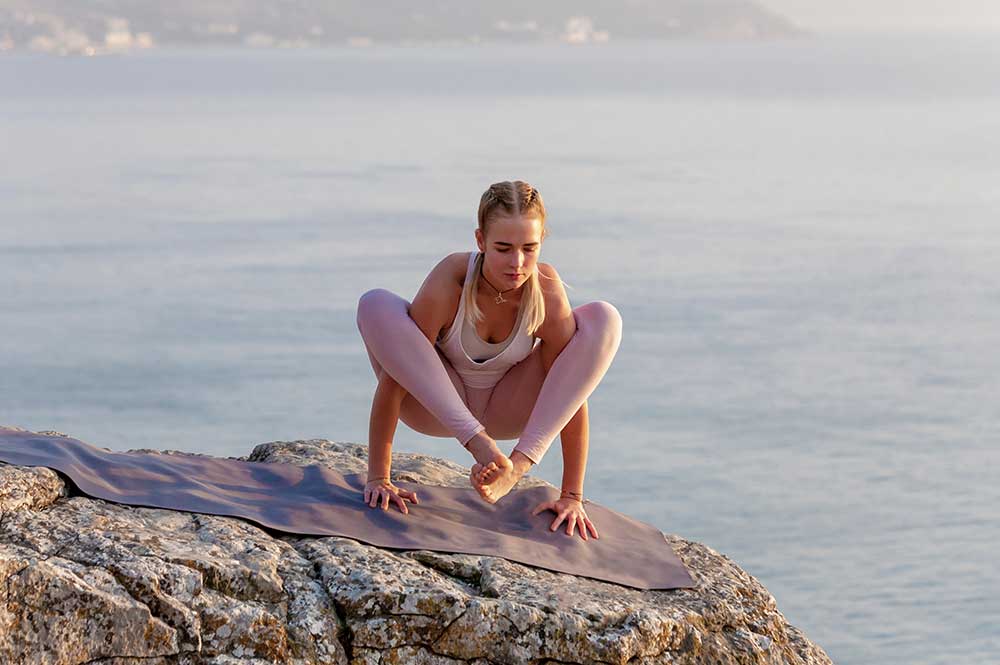
This pose is great for the intermediate yogi and requires a lot of strength.
- Step 1: Start in a squat position with your hands on the mat. Make sure your weight is leaning forward.
- Step 2: Take your hands behind your feet and lift your hips off the ground. Reach your calf around your shoulder and step your heels on both hands until your palms are flat against the mat.
- Step 3: Bend your arms and knees with feet on the floor and cross them over each other.
- Step 4: Press into your hands and lift your feet off the floor. Hold this position for 5-10 breaths.
- Step 5: To release, place your feet back on the floor and uncross your ankles. Take one leg behind your arm and then the other. Lower your hips to the ground.
#3 Karnapidasana — Ear to Knee Pose
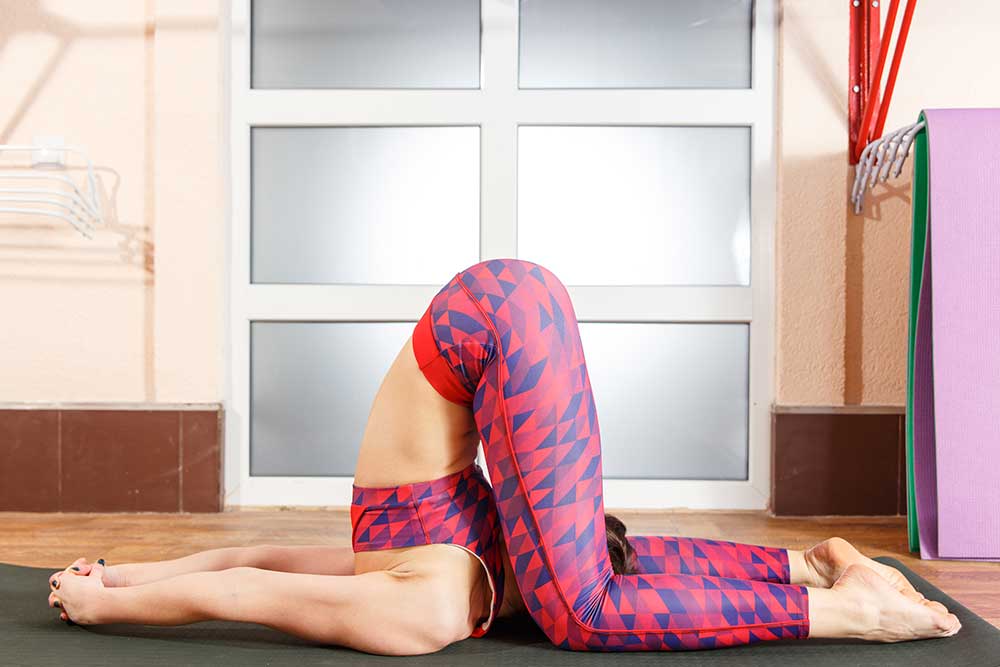
This is an inversion and shoulderstand that helps to quiet the mind and release tension in the spine.
- Step 1: Lie flat on your back with your legs extended. Inhale and lift your legs up towards the ceiling.
- Step 2: Lift your hips off the mat and place your hands behind your lower back, bending your elbows at a 90 degree angle.
- Step 3: Lower your legs behind your head until your toes touch the ground behind you. Lower your arms straight down to the mat.
- Step 4: Bend your knees and bring them beside your ears. Leave your arms where they are or wrap them around the back of your leg. Hold this position for 10 breaths.
- Step 5: To release, straighten out your legs and support your lower back. Lift your legs back up and bend your knees, lowering your back onto the mat.
#4 Yoga Nidrasana — Sleeping Yogi Pose
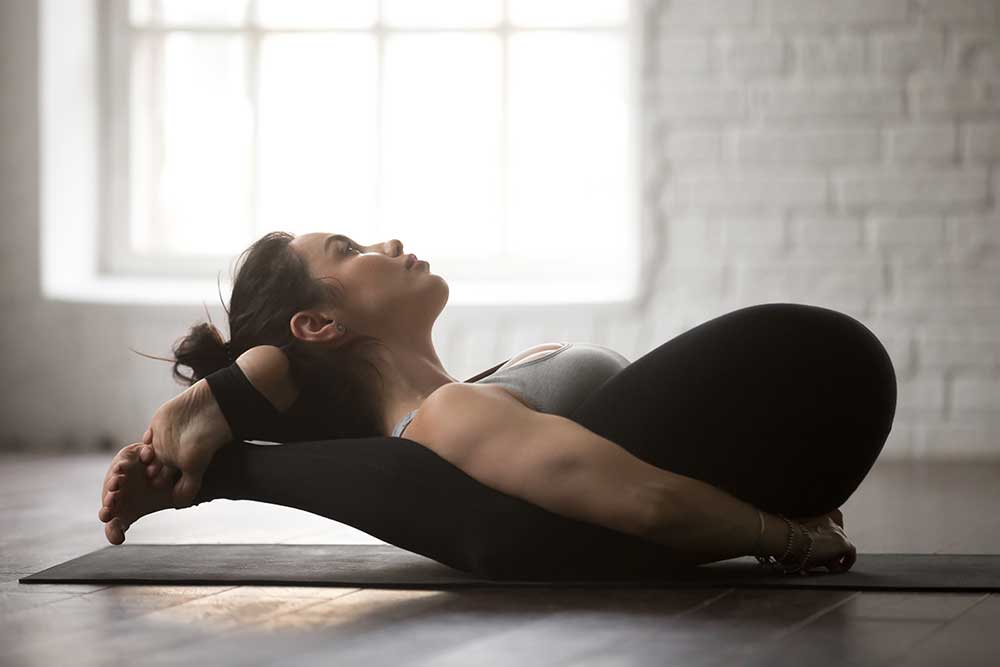
This pose requires flexibility and external rotation in the hips.
- Step 1: Lie down on your back and bend your knees into your chest. Open your knees out to each side and cross one foot over the other
- Step 2: Reach under your legs to bring your feet towards your forehead. Let your sitz bones come up off the ground.
- Step 3: Press your feet towards the floor behind you and weave your head through your legs. Let your head rest on your feet and bring your hands in a prayer position. Hold this posture for several breaths.
- Step 4: To release, bring your feet back in front of your head and release your legs down to the mat.
#5 Mukta Hasta Sirsasana C — Iron Cross Headstand Pose
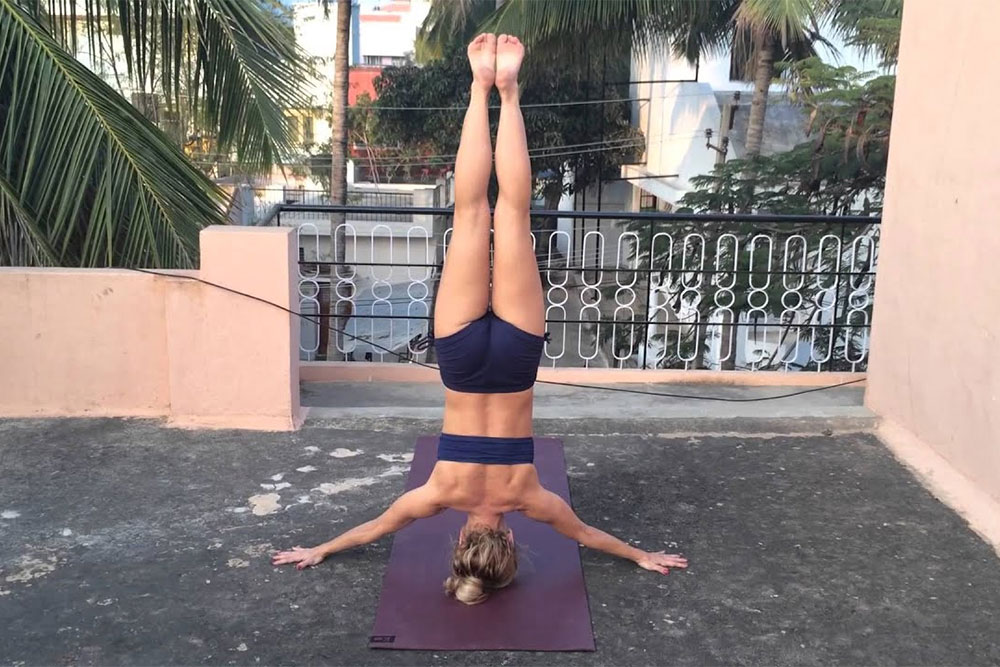
This posture requires patience, focus, and hardcore balance.
- Step 1: Bring your hands and knees into a tabletop position and place the top of your head on the ground. Bend your elbows at a 90-degree angle and lay your forearms on the mat.
- Step 2: Walk your hands out on either side of your head, keeping your elbows bent. Straighten your legs and walk them in towards your head.
- Step 3: Shift your hips over your shoulders and use the muscles of your core to lift both of your legs up off the mat. Straighten your legs and keep them together with toes pointed so you are in a tripod headstand.
- Step 4: If you feel stable here, walk your hands out further away from your head and straighten your arms out with palms facing down on the floor.
- Step 5: Hold for 5 breaths. To release, bring your feet down to the earth and come into child’s pose.
#6 Mayurasana — Peacock Pose
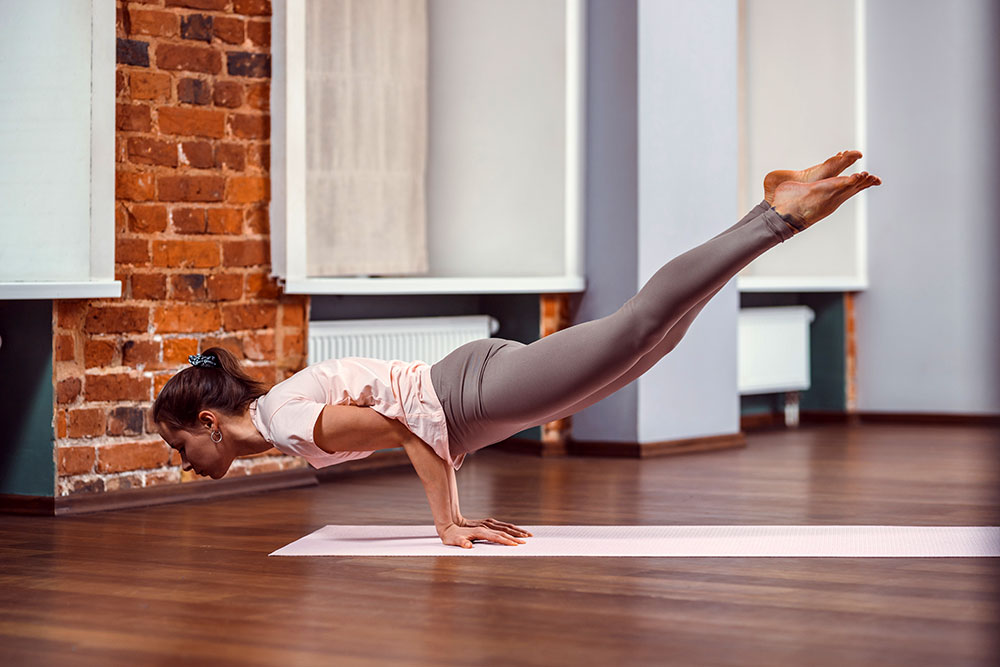
This pose requires power in the glutes and core.
- Step 1: Come to the mat on your hands and knees and point your wrists in towards each other. Spread your fingers out on the mat and experiment with your hands touching one another or being slightly apart.
- Step 2: Shift your weight forward, bringing your heels up close to your glutes. Lean forward and bend your elbows to bring yourself in line with your belly button.
- Step 3: With your eyes looking forward, lift your knees up off the floor. Your chest should be far forward as your legs lift up and out behind you. Hold this posture for 5 breaths.
- Step 4: To release, bend your knees back and bring your feet down to the earth. Lift off of your arm balance and bring yourself back into a tabletop position.
#7 Vrschikasana — Handstand Scorpion Pose
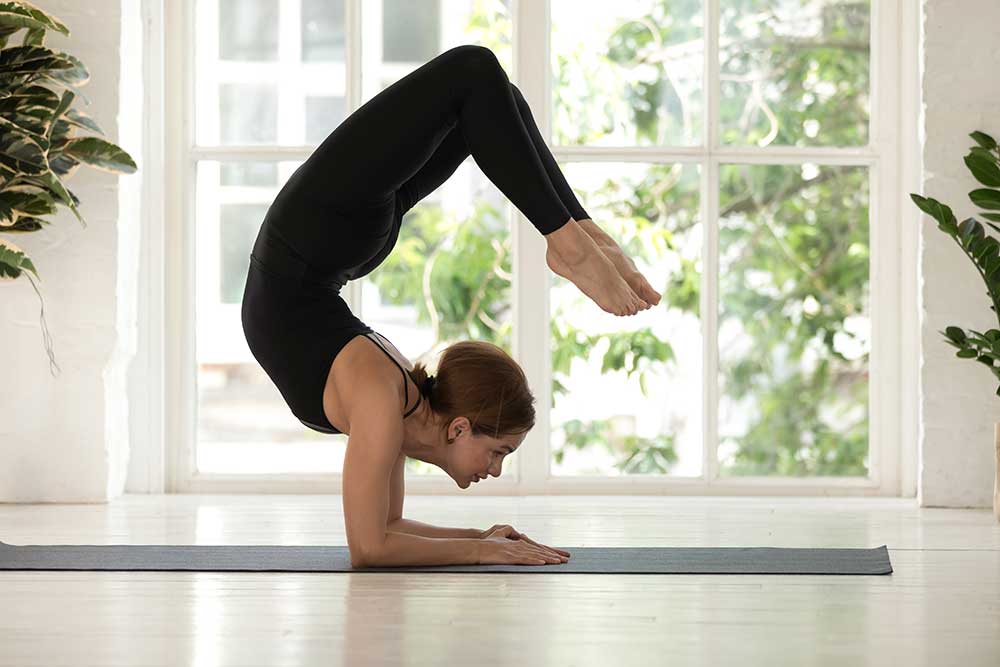
This handstand and deep backbend require strength in your upper body and stability within your core.
- Step 1: Begin in Downward-Facing Dog and move your shoulders over your hands. Lift your legs off of the floor and straighten them up to a straight line to find your balance.
- Step 2: Move your chest forward and gaze in front of you, shifting your hips over your shoulders so your legs can extend overhead.
- Step 3: Open your legs and bend your knees, bringing your toes together overhead. Hold this posture for 5 breaths.
- Step 4: To release, straighten your legs back up and into a handstand. Lower your legs to the floor and come back into Downward-Facing Dog.
Please note that for any deep backbends, it is important to do a counter posture afterward so take child’s pose for about 10 breaths.
#8 Eka Pada Viparita Dandasana — One-Legged Inverted Staff Pose
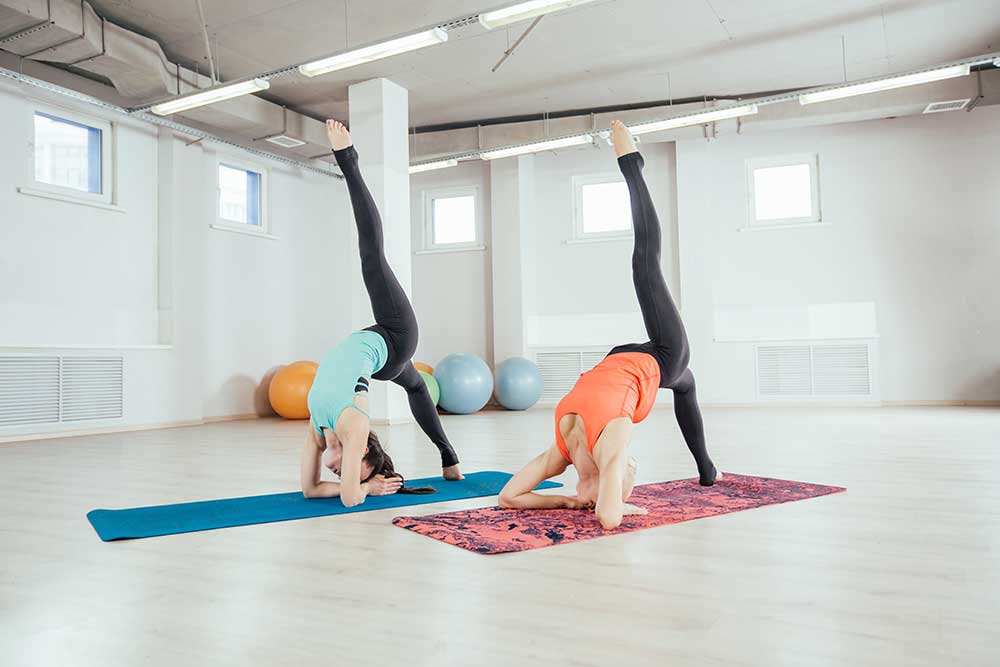
This deep backbend stretches the back of your arms and opens up the front chakras of the body.
- Step 1: Lay down on your back on the mat and bring your feet close to your sitz bones with your heels hip-width apart. Place your hands up by your shoulders.
- Step 2: Lift your body off of the mat, placing the crown of your head onto the floor. Drop both forearms to the floor by your head and straighten both legs as you lift through your feet and pelvis.
- Step 3: Lift one leg up to the ceiling and hold for 5 breaths. Lower your leg back down and lift the other, holding for 5 breaths.
- Step 4: To release, bend your knees and place the crown of your head back down to the mat. Lift your forearms off of the mat and place your palms by your head. Lower down to the mat one vertebrae at a time.
#9 Visvamitrasana — Visvamitra’s Pose
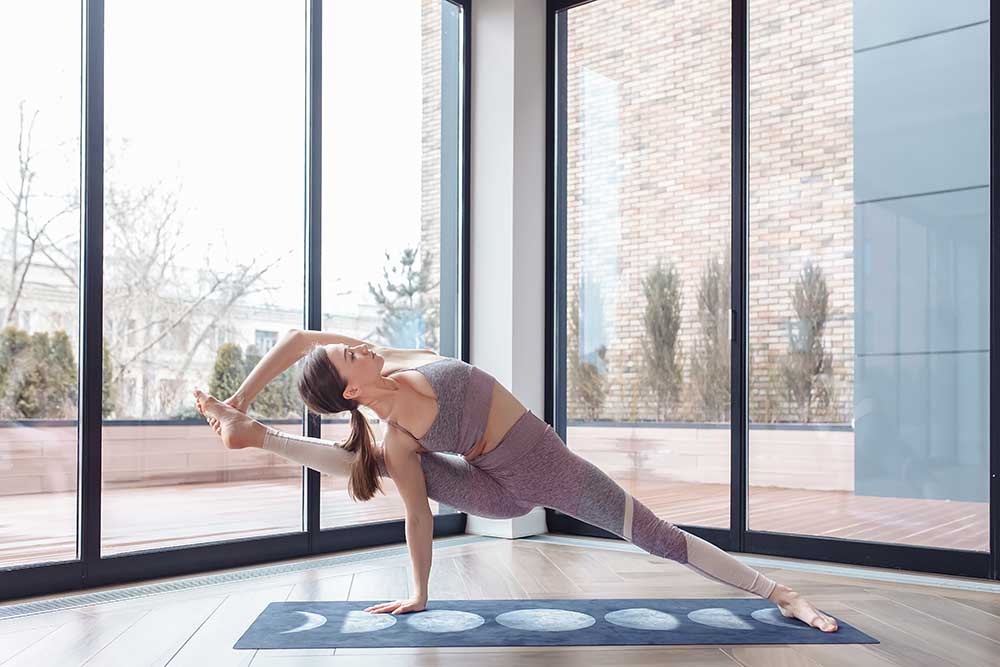
This is an arm balance and twist that opens up the side waist and torso.
- Step 1: Begin in Downward-Facing Dog and lift your right leg up to the ceiling. Bring your right leg forward into a lunge with your foot in between your hands. Tuck your right shoulder underneath your right knee and turn your left foot out.
- Step 2: Grab the outside of your right foot with your left hand, balancing on your right arm. Open your rib cage and left side body up to the sky.
- Step 3: Straighten your right leg out to the side and stretch your side body deeply. Lift through the arch of your left foot and hold for 5-10 breaths.
- Step 4: To release, return to a lunge and transition to Downward-Facing Dog. Repeat this sequence on the left side.
#10 Natarajasana — Dancer Pose
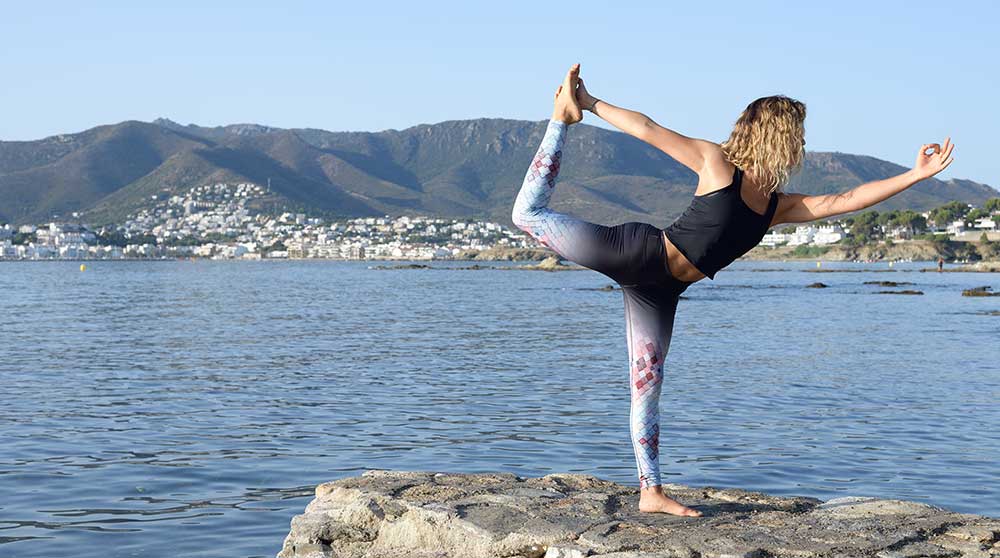
This pose requires core strength and a good sense of balance.
- Step 1: Stand in tadasana and find your dristi. Transfer your weight into your left leg and take your right foot with your right hand. Straighten your right leg out and externally rotate it to the side.
- Step 2: Bend your knee behind you and press your chest forward. Grab your foot on the outside and lift it towards your shoulder.
- Step 3: Flip your shoulder by grabbing the top of your foot with your hand and bend your elbow at a 90-degree angle.
- Step 4: Reach back with both hands, stretching your leg up and opening the front of your body all the way up through your arms. Hold this posture for 5 breaths.
- Step 5: To release, loosen your grip off of your foot and lower your leg back down to the floor. Repeat this sequence on the other side.
#11 Padmasana — Handstand Lotus Pose
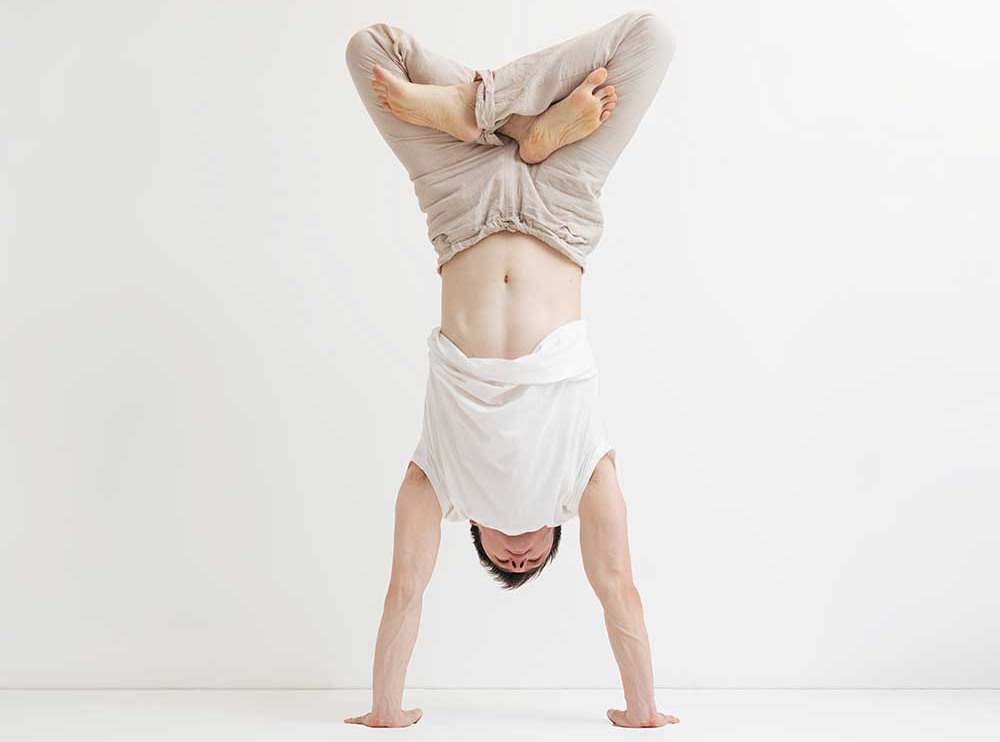
This posture helps stretch the ankles and knees while stimulating the spine, pelvis, abdomen, and bladder.
- Step 1: Start in Downward-Facing Dog and stack your shoulders over your hands. Lift your legs one at a time into a handstand posture.
- Step 2: Cross your legs and fold into a lotus pose, lowering your hips. Hold this posture for 5 breaths.
- Step 3: To release, uncross your legs and lift them back up into a handstand. Bend your knees and place your feet back on the mat behind you.
#12 Kurmasana — Tortoise Pose
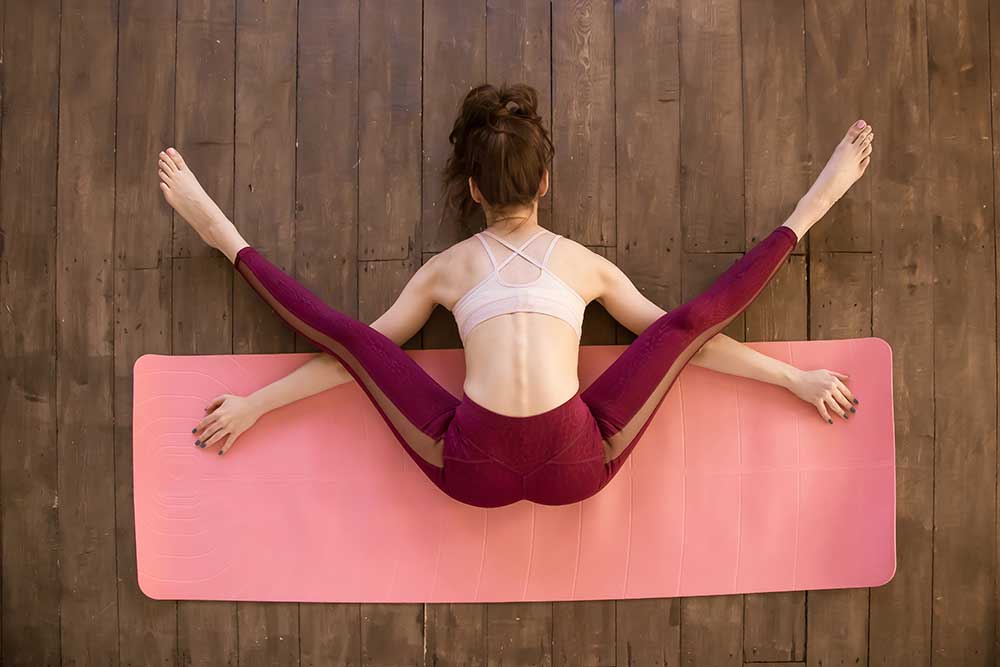
This pose is a deep stretch for the hips and hamstrings.
- Step 1: Sit in dandasana. Bend both knees and open up your feet one leg’s length apart.
- Step 2: Open your knees and slide your arms out to the side and slightly back behind the line of your hips. Wiggle your shoulders underneath your knees and bring your feet closer together.
- Step 3: Lower your torso to the mat and straighten your arms under your legs. Straighten your legs over your arms with flexed feet and hold for 5 breaths.
- Step 4: To release, inhale and release your arms out from underneath your legs. Bring them forward between your legs.
#13 Padangustha Dhanurasana — Big Toe Bow Pose
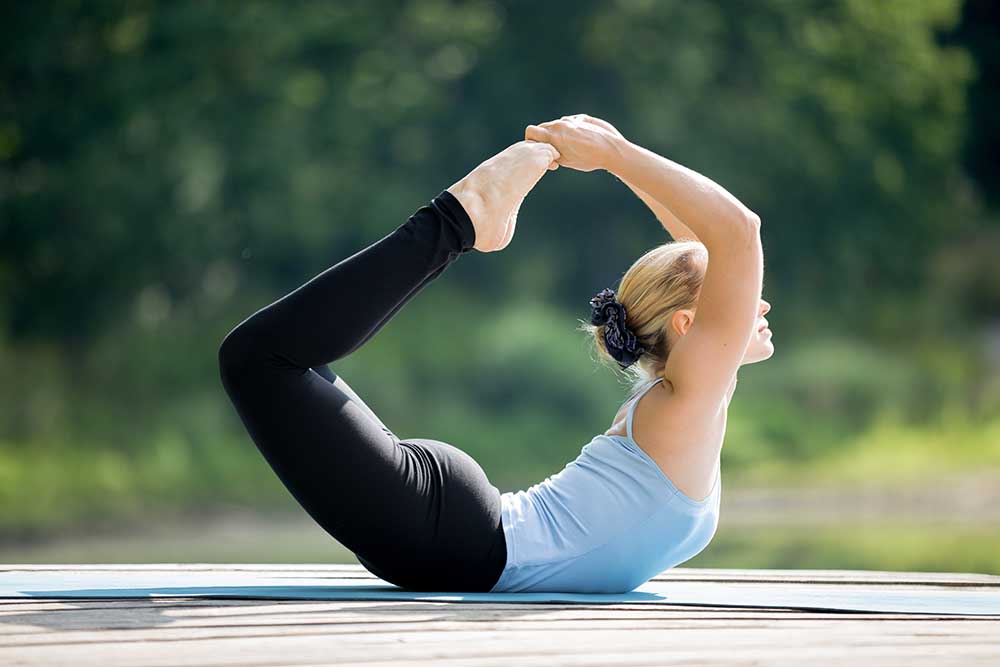
This is a deep backbend that activates the sacral and root chakras while stretching your entire body.
- Step 1: Begin in a sphinx pose. Bend your right leg behind you and reach for your foot with your right hand.
- Step 2: Bend your left leg behind you and reach for your foot with your left hand.
- Step 3: Lift your feet and hands so you are balanced on your pelvis and belly.
- Step 4: To release, let go of each leg one at a time and return to a sphinx posture.
#14 Bheksana — Frog Pose
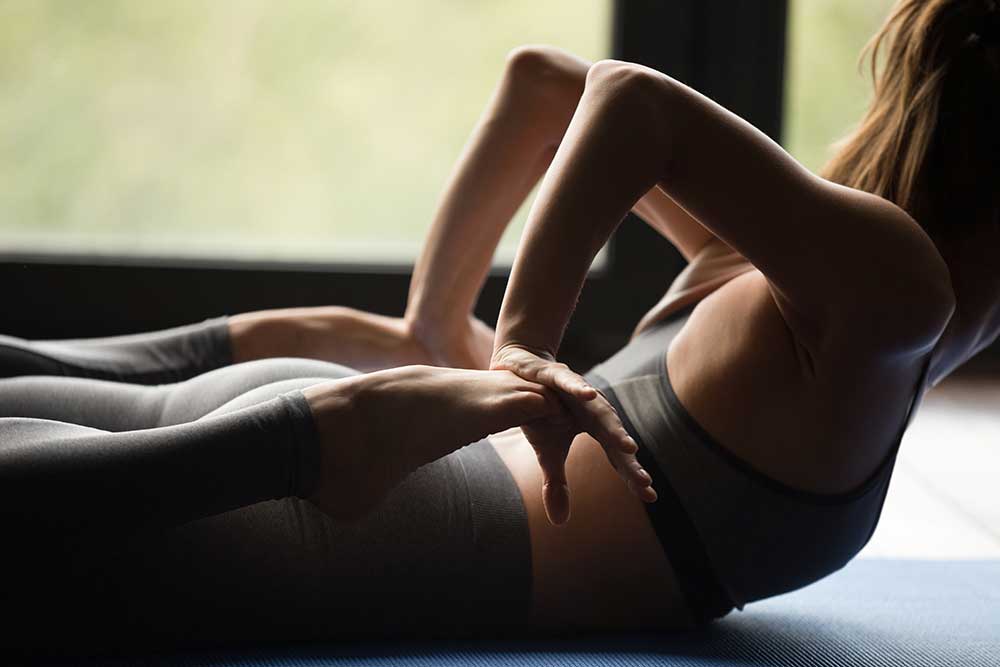
This posture stretches the hips and quadriceps while opening up the root chakra.
- Step 1: Begin in sphinx pose. Bend your right leg behind you, taking your calf muscle out to the side of your thigh and hip with your right hand.
- Step 2: Bend your left leg behind you and out to the side. Press the tops of both feet down onto the mat with your palms.
- Step 3: Lift your upper torso off the mat and open up your chest.
- Step 4: To release, lower your body down and release your legs behind you.
#15 Tittibhasana — Firefly Pose
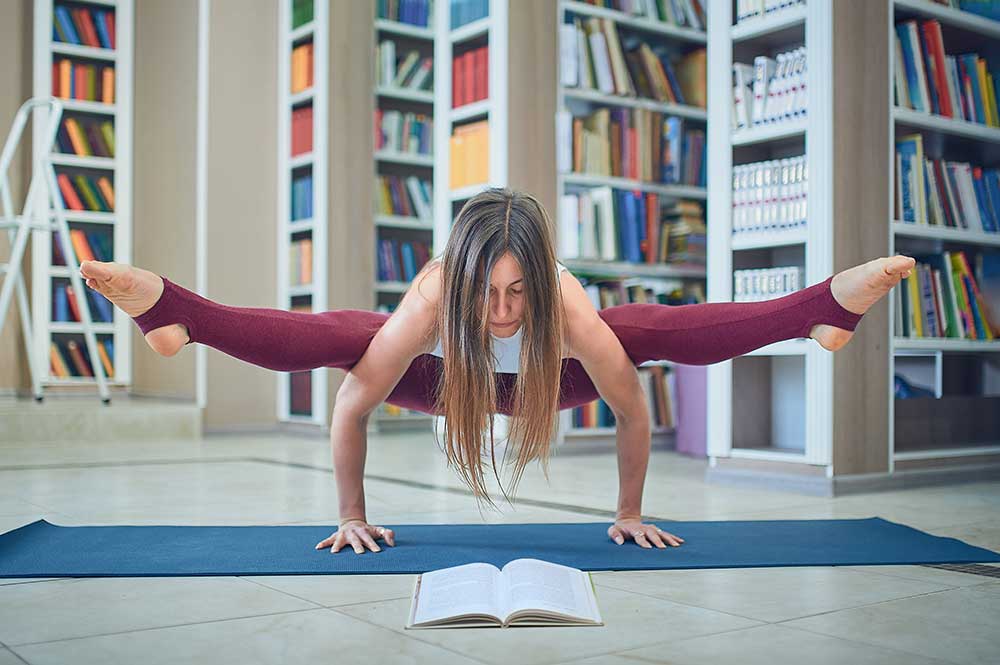
This pose is a challenge for the legs, core, and arms, and requires strength and flexibility throughout your entire body.
- Step 1: Begin by standing on the mat with your feet slightly wider than hip’s distance. Your toes should be pointed out to a 45-degree angle. Bend your knees and come down into a squat with your heels on the earth.
- Step 2: Press your palms together in Anjali mudra, opening your knees with your elbows. Place your hands down on the mat and lift your hips. Press your legs into your upper arms.
- Step 3: Bring your hands behind your heels on the floor and place your knees over your upper arms, coming into a squat.
- Step 4: Shift your weight into your hands and lift each foot off of the mat. Straighten your legs out in front of you, squeezing your thighs against your arms. Hold this posture for 5 breaths.
- Step 5: To release, bend your knees and bring your feet to the mat. Release your arms and come down onto your sitz bones.
What's Your Reaction?
Meditation coach Emma Morrison is the go-to person for those living in Salt Lake City, Utah, who need to release stress and tension or simply dive deeper into their meditation practice. In her writing, you’ll receive useful information on how to live a more fulfilling life.






